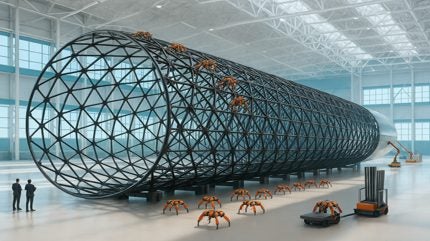
H2 Clipper (H2C), a developer of hydrogen-based infrastructure and transportation, has been awarded a US patent for its advanced swarm robotics technology in aircraft and aerospace manufacturing.
The patent, number 12,234,035, is a continuation of H2C’s foundational robotics patent and represents the company’s 15th awarded patent.

Discover B2B Marketing That Performs
Combine business intelligence and editorial excellence to reach engaged professionals across 36 leading media platforms.
Traditionally, aircraft manufacturing requires large facilities and complex logistics.
H2C’s swarm robotics method enables in-place construction, eliminating the need for extensive assembly line infrastructure and reducing logistical challenges.
The patented system introduces a network of robots that collaboratively and autonomously construct large aerospace structures.
This approach allows for a smaller production facility footprint and includes automated manufacturing, optimisation, scalability, and heavy-lift robotics integration.

US Tariffs are shifting - will you react or anticipate?
Don’t let policy changes catch you off guard. Stay proactive with real-time data and expert analysis.
By GlobalDataThe technology features machine learning and generative AI that can guide the swarm of robots to assemble airframes, install components, and conduct quality inspections with high precision while reducing errors.
This flexibility in construction supports various assembly methods, reduces infrastructure needs, and improves overall safety.
Initially aimed at constructing H2C’s Pipeline-in-the-Sky airships, the technology’s benefits extend to broader aviation and aerospace manufacturing challenges, according to the company.
H2C founder and CEO Rinaldo Brutoco said: “The issuance of this patent marks a pivotal moment in the evolution of aerospace and aviation manufacturing.
“By replacing traditional assembly lines with robotic swarms, this breakthrough enables aircraft and large aerospace assets to be built faster, at a significantly lower cost, and with far greater precision.”
With the new patent in hand, H2C is assembling an expert team from various fields to guide the development and demonstration of this technology.
The team’s insights will contribute to a technology roadmap and potentially lead to a broader industry consortium to promote the adoption of swarm robotics in the sector.
Additionally, H2C’s collaboration with Dassault Systèmes via the 3DEXPERIENCE Lab accelerator programme, along with a renewed three-year contract in 2024, reinforces its focus on developing robotic software for aerospace manufacturing.
According to GlobalData’s Civil Aviation Patent Analytics, this patent award for H2C is an outlier, with publications, filings and grants (awards) all down in Q1 2025. Looking at those grants that have been made, however, it is unsurprising the award was made in the US, which leads the pack in registered innovations by several thousand per year.
You can find more on patent rates and wider intelligence on the civil aviation sector by buying access to GlobalData’s Intelligence Centre.





